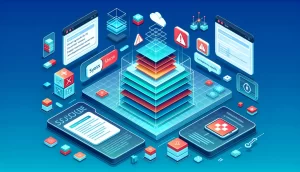Threat Modeling for Web Application Security: A Comprehensive Guide
Threat modeling is a strategic process designed to identify, assess, and mitigate potential threats to web applications. By adopting a top-down perspective on security risks, organizations can focus on informed decision-making that prioritizes cybersecurity efforts and allocates resources efficiently. This proactive approach is essential in today’s rapidly evolving cyber threat landscape, where vulnerabilities can lead to significant data breaches and operational disruptions.
Understanding Threat Modeling and Its Importance in Web Application Security
Threat modeling is a form of risk assessment that evaluates both attack vectors and defensive measures related to digital assets such as applications, data, host systems, and environments. According to the NIST SP 800-154 publication, the foundational concept behind threat modeling involves acknowledging limited security resources and optimizing their utilization to protect critical assets effectively.
Considering the increasing rate of cyberattacks targeting web applications, threat modeling becomes indispensable. The 2023 IBM Cost of a Data Breach Report highlights that 43% of breaches involved web application attacks, underscoring the urgency of robust security assessment methodologies.
How Is Threat Modeling Performed?
Threat modeling invites security teams to think like attackers, asking key questions such as:
- What assets are valuable and worth protecting?
- How might these assets be targeted?
- Where would an attacker likely begin an intrusion?
Visual tools play a critical role by mapping out systems, enabling security professionals to better identify and understand potential attack vectors. For example, security architects often create Data Flow Diagrams (DFDs) to outline data movement, trust boundaries, and system components.
An analogy is securing a home: drawing the layout, identifying entry points like doors and windows, assessing what valuables might tempt a burglar, and implementing defenses such as locks or alarm systems. The same thoughtful process applies directly to securing web applications and their surrounding environments.
Why Web Application Threat Modeling Must Encompass Entire Ecosystems
Web applications rarely operate in isolation. They interact with web servers, application servers, databases, operating systems, and often interconnected third-party services. Isolating threat modeling exclusively to the web tier risks overlooking critical vulnerabilities elsewhere, potentially exposing the entire system.
Key points to consider:
- Map all components your web application interacts with.
- Identify indirect attack paths through connected systems.
- Evaluate external factors such as user behavior and third-party integrations.
Who Should Participate in Threat Modeling?
Successful threat modeling depends on collaborative input across multiple roles within an organization to capture diverse perspectives:
- Security experts: Provide technical insight into vulnerabilities and attack techniques.
- Developers: Bring understanding of application architecture and codebase sensitivities.
- Business stakeholders: Highlight valuable assets and potential reputational risks.
- IT administrators: Focus on infrastructure, network, and device security.
- Third parties: Sometimes involve subcontractors, partners, or users for comprehensive review.
For instance, a marketing team might stress the impact of website defacement on brand trust, while system administrators may flag insecure IoT devices that broaden the attack surface.
When and Where Should Threat Modeling Be Integrated?
Effective threat modeling should commence at the earliest stages of the software development lifecycle (SDLC) and continue throughout the application’s operational life.
Best practices for timing and scope include:
- Design Phase: Conduct initial threat modeling during architecture and design to catch security flaws early when remediation is less costly.
- Development and Deployment: Update threat models as features evolve or new vulnerabilities emerge.
- Ongoing Maintenance: Regularly revisit models following environment changes or integration of new dependencies.
The dynamic nature of IT environments means even minor updates may introduce serious threats unless continuously monitored and mitigated.
Stages of Threat Modeling Explained
Threat modeling typically follows four essential stages:
- 1. System Understanding (Diagramming): Create clear visual representations like data flow diagrams that outline components, data movement, and trust boundaries.
- 2. Threat Enumeration: Identify potential threats across categories such as spoofing, tampering, repudiation, information disclosure, denial of service, and privilege escalation.
- 3. Mitigation Strategies: Develop actionable plans to eliminate or reduce risks—this can include implementing security controls, code changes, or infrastructure adjustments.
- 4. Verification: Validate the effectiveness of mitigations through testing, code reviews, or security assessments to ensure vulnerabilities are addressed.
For web applications, threat enumeration should always consider common vulnerabilities such as the OWASP Top 10, including SQL injection, cross-site scripting (XSS), and insecure authentication.
Real-World Example
A 2023 Verizon Data Breach Investigations Report (DBIR) found that web applications accounted for over 40% of data breaches, with injection attacks and stolen credentials as primary causes. This emphasizes the critical need for thorough threat modeling and mitigation focused on web-layer vulnerabilities.
Popular Threat Modeling Methodologies
Multiple methodologies can guide the threat modeling process. Selection depends on factors like organizational size, development methodology, and security goals. Key approaches include:
- STRIDE: Developed by Microsoft, addresses six threat categories: Spoofing, Tampering, Repudiation, Information disclosure, Denial of service, and Elevation of privileges.
- PASTA (Process for Attack Simulation and Threat Analysis): Risk-centric, emphasizing attack simulations aligned with business objectives.
- Trike: Focuses on risk management to satisfy stakeholder requirements.
- VAST (Visual, Agile, and Simple Threat Modeling): Designed for Enterprise and scalable DevOps environments.
For organizations seeking to explore these methodologies in detail, the Carnegie Mellon University Software Engineering Institute provides an excellent overview of twelve leading threat modeling frameworks.
Tools to Facilitate Threat Modeling
Automation tools can enhance threat modeling efficiency and accuracy. Among numerous options, the Microsoft Threat Modeling Tool is widely recognized for its ease of use and extensive training resources. Other tools integrate threat modeling with SDLC and DevSecOps pipelines, providing continuous feedback as code evolves.
Integrating Threat Modeling Into Cybersecurity Strategy
Modern cybersecurity frameworks emphasize incorporating threat modeling as a continuous process, not a one-time event. This inclusion enables organizations to anticipate emerging threats and adjust defenses preemptively. Integrating threat modeling within continuous integration/continuous deployment (CI/CD) practices enhances agility and resilience against attacks.
Summary: Key Takeaways on Threat Modeling for Web Application Security
- Threat modeling offers a structured approach to understanding and mitigating security risks for web applications and associated systems.
- Cross-functional collaboration enriches the process and uncovers diverse threat perspectives.
- Ongoing threat modeling is necessary to keep pace with evolving technologies and attack techniques.
- Methodology and tool selection should align with organizational needs, development workflows, and technical architecture.
- Leveraging automation can optimize threat detection, prioritization, and remediation steps.
By embedding threat modeling into the heart of web application security, organizations build more resilient digital environments capable of withstanding sophisticated cyber threats. This strategic foresight ultimately reduces risk exposure, protects critical assets, and supports business continuity in a threat-prone digital era.



